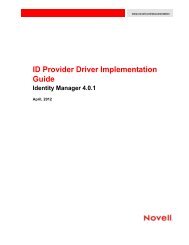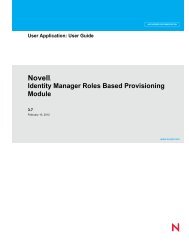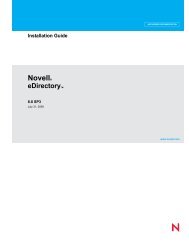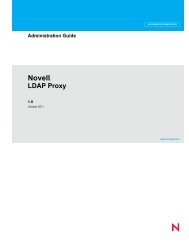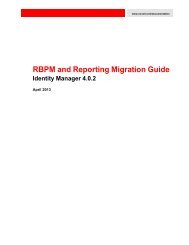Identity Manager 4.0.1 Driver for Scripting Implementation ... - NetIQ
Identity Manager 4.0.1 Driver for Scripting Implementation ... - NetIQ
Identity Manager 4.0.1 Driver for Scripting Implementation ... - NetIQ
You also want an ePaper? Increase the reach of your titles
YUMPU automatically turns print PDFs into web optimized ePapers that Google loves.
1.1.2 Subscriber Channel<br />
The Subscriber channel receives XDS command documents from the Metadirectory engine and calls<br />
the appropriate script or scripts to handle the command.<br />
The provided scripts must be customized to handle connected system events. For more in<strong>for</strong>mation<br />
see Chapter 5, “Customizing the <strong>Scripting</strong> <strong>Driver</strong>,” on page 35.<br />
1.1.3 Scriptable Framework<br />
The interface between the connected system and the driver shim uses customizable scripts. You<br />
must extend the scripts that are provided with the driver to support your connected system. Several<br />
utility scripts and helper commands are provided with the driver to facilitate communication with<br />
the driver shim and the change log. An extensible connected system schema file allows you to add<br />
your own objects and attributes to those already supported by the driver.<br />
For more in<strong>for</strong>mation about the scriptable framework, see Chapter 5, “Customizing the <strong>Scripting</strong><br />
<strong>Driver</strong>,” on page 35.<br />
1.1.4 Schema File<br />
The configuration of class and attribute definitions <strong>for</strong> the connected system is specified using the<br />
schema file. You can modify and extend this file to include new objects and attributes. For details<br />
about configuring the schema file, see Section 5.2, “The Connected System Schema File,” on<br />
page 38.<br />
1.1.5 Include/Exclude File<br />
The include/exclude file allows local system policy to en<strong>for</strong>ce which objects are included or<br />
excluded from provisioning, on both the Publisher channel and the Subscriber channel,<br />
independently. For details about using the include/exclude file, see Section 5.3, “The Connected<br />
System Include/Exclude File,” on page 40.<br />
1.1.6 Loopback State Files<br />
The loopback state files are used to provide automatic loopback detection <strong>for</strong> external applications<br />
that do not have mechanisms to per<strong>for</strong>m loopback detection. This loopback detection prevents<br />
subscribed events from being published back to the <strong>Identity</strong> Vault.<br />
1.2 Configuration Overview<br />
This section discusses driver configuration details specific to the <strong>Scripting</strong> driver. For basic<br />
configuration in<strong>for</strong>mation, see “Managing <strong>Identity</strong> <strong>Manager</strong> <strong>Driver</strong>s” in the <strong>Identity</strong> <strong>Manager</strong><br />
Administration Guide. For detailed in<strong>for</strong>mation about configuring the <strong>Scripting</strong> driver, see<br />
Chapter 4, “Configuring the <strong>Scripting</strong> <strong>Driver</strong>,” on page 25.<br />
Topics in this section include<br />
• Section 1.2.1, “Data Flow,” on page 14<br />
• Section 1.2.2, “Policies,” on page 14<br />
Overview 13








